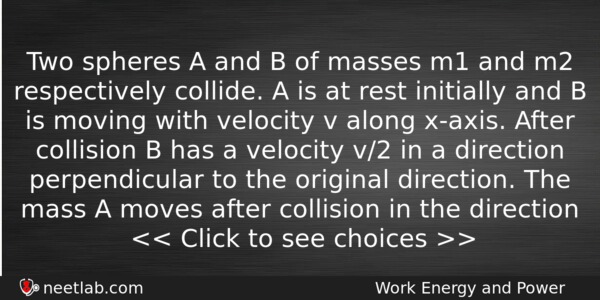| ⇦ | 
| ⇨ |
Two spheres A and B of masses m1 and m2 respectively collide. A is at rest initially and B is moving with velocity v along x-axis. After collision B has a velocity v/2 in a direction perpendicular to the original direction. The mass A moves after collision in the direction
Options
(a) same as that of B
(b) Opposite to that of B
(c) θ = tan⁻¹ (1/2) to the x-axis
(d) θ = tan⁻¹ ( -1/2) to the x-axis
Correct Answer:
θ = tan⁻¹ (1/2) to the x-axis
Explanation:
No explanation available. Be the first to write the explanation for this question by commenting below.
Related Questions: - Planck’s constant has same dimensions as those of
- An atom bomb works on the principle of
- When a metallic surface is illuminated with radiation of wavelength λ,
- The height of the dam, in an hydroelectric power station is 10 m. In order to generate
- The velocity of sound is V, in air. If the density of air is increased to four times
Topics: Work Energy and Power
(94)
Subject: Physics
(2479)
Important MCQs Based on Medical Entrance Examinations To Improve Your NEET Score
- Planck’s constant has same dimensions as those of
- An atom bomb works on the principle of
- When a metallic surface is illuminated with radiation of wavelength λ,
- The height of the dam, in an hydroelectric power station is 10 m. In order to generate
- The velocity of sound is V, in air. If the density of air is increased to four times
Topics: Work Energy and Power (94)
Subject: Physics (2479)
Important MCQs Based on Medical Entrance Examinations To Improve Your NEET Score
18000+ students are using NEETLab to improve their score. What about you?
Solve Previous Year MCQs, Mock Tests, Topicwise Practice Tests, Identify Weak Topics, Formula Flash cards and much more is available in NEETLab Android App to improve your NEET score.
Share this page with your friends

Leave a Reply